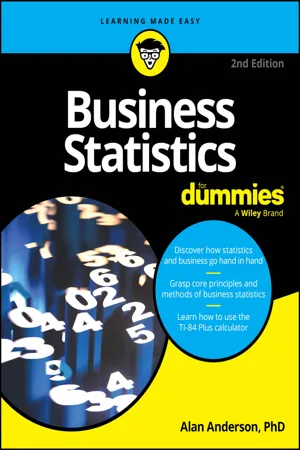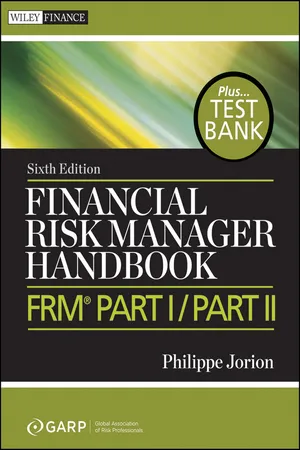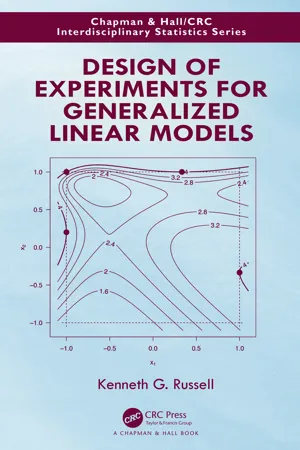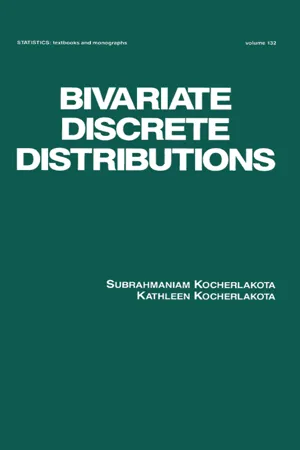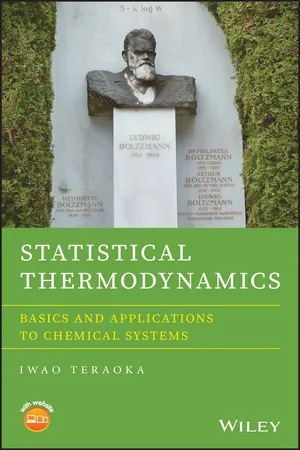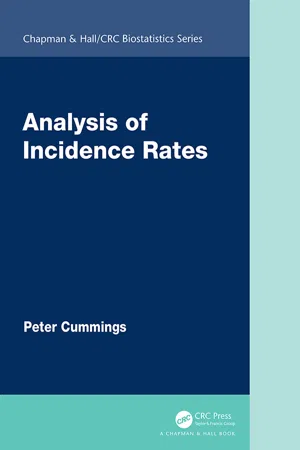Mathematics
Mean and Variance of Poisson Distributions
The mean of a Poisson distribution represents the average number of events that occur in a given interval, while the variance measures the spread or dispersion of the distribution. For a Poisson distribution, the mean and variance are both equal to the parameter λ, which represents the average rate of occurrence for the events being modeled.
Written by Perlego with AI-assistance
Related key terms
Related key terms
1 of 4
Related key terms
1 of 3
12 Key excerpts on "Mean and Variance of Poisson Distributions"
- eBook - ePub
Statistical Methods for Geography
A Student’s Guide
- Peter A. Rogerson(Author)
- 2019(Publication Date)
- SAGE Publications Ltd(Publisher)
Table 3.6 . The observed frequencies are similar to what one would expect if pebbles were distributed randomly across sets.Table 3.6To this point, several of our examples illustrating the Poisson distribution have involved questions where the variable of interest is the number of events that occur in (continuous) time. Because the Poisson distribution is a result of dividing time up into a very large number of independent trials, the Poisson distribution is essentially modeling the number of events that occur randomly in time. This distribution lies at the core of queueing theory – the theory of queues, or lines (e.g., the length of lines that people stand in at stores, etc.). Assuming random arrivals of people in time, the number of people who arrive in a given interval of time will follow a Poisson distribution. If cars arrive randomly at a traffic light at the rate of three every ten seconds, we can use the Poisson distribution to determine, e.g., the probability that six cars will arrive in the next ten seconds (= e−3 36 /6! = 0.0504).We have already noted that the expected value or theoretical mean of the Poisson distribution is equal to λ. The theoretical variance of the Poisson distribution is also equal to λ; if we observed the actual counts that occurred during a large number of time periods, we would find that the sample variance associated with these counts would be close to this theoretical variance.Importantly, the Poisson distribution may also be used to model events that occur randomly in space. Suppose that towns are randomly located throughout an area, with a mean density of two towns every 30 square kilometers. How many towns would we expect in a 50 square kilometer area? What is the probability that we find fewer than two towns in a 50 square kilometer area? The answers to these questions are found from proceeding exactly as before, except we now use spatial units instead of temporal ones. The mean number of towns in a 50 square kilometer area is found from λ/50 = 2/30, and this implies that λ = 3.33 (if there are two towns on average in a 30 square kilometre area, there are 3.33 towns on average in a 50 square kilometre area). To answer the second question, we use this value of λ in the Poisson distribution: - eBook - ePub
- Alan Jeffrey(Author)
- 2004(Publication Date)
- Chapman and Hall/CRC(Publisher)
standard deviation , and provides a measure of the spread of the distribution about the mean. The advantage of using the standard deviation is that it makes it unnecessary to work with squared units of the measured quantity.We leave to the reader as exercises in manipulation the task of proving the following results: Binomial distributionprobability density, nP( r )=(n r)p ′,(1 − p)n − rr = 0 , 1 , …mean μ = np , variance σ 2 = np (1 −p ).Poisson distributionprobability densityP( r )=,μ re− μr !r = 0 , 1 , 2 , …mean μ=np , variance σ 2 = μ.18.3 Continuous distributions and the normal distribution
18.3.1 Continuous distributions
So far the sample spaces we have used have involved discrete points, and it is for this reason tlιat the term ‘discrete’ has been used in conjunction with the definition of the binomial and Poisson distributions. In other words, in discrete distributions, no meaning is to be attributed to points that are intermediate between the discrete sample-space points.When different situations involving probability are examined it is often necessary to consider sample spaces in which all points are allowed. This happens, for instance, when considering the actual measured lengths of manufactured items having a specific design length, or when considering the actual measured capacity of capacitors, all having the same nominal capacity.The probability density for situations like these can be thought of as being arrived at as the limit of an arbitrarily large number of discrete observations in the following sense. Suppose first that all the measured quantities x lie within the interval a ≤x ≤b. Next, consider the division of [a, b ] into n equal intervals of length Δ = (b − a )/n and number them sequentially from i = 1 to n starting from the left-hand side of the interval [a, b ]. Thus the zth interval corresponds to the inequality a + (i − 1)Δ < x < a + i Δ. Now in the set or sample of N measurements taken from the population or totality of all possible measurements, it will be observed thatfiof these lie within the zth interval. This number ƒi is the observed frequency of occurrence of a measurement in the i th interval, and it is obvious thatIf a histogram were to be constructed at this stage by plotting the numbers= N∑i = 1nf ifi /Nagainst i then it would appear as in Fig. 18.8(a) - eBook - ePub
- Alan Anderson(Author)
- 2023(Publication Date)
- For Dummies(Publisher)
= 1 column. The probability is 0.1839.If you don’t care for using formulas or a table, try a specialized calculator or Excel. The Excel function is POISSON.DIST.The moments of the Poisson distribution are used to represent the average value of the distribution and the dispersion of the distribution. As with the binomial distribution, these moments may be computed with simplified formulas.Poisson distribution: Calculating the expected value
As with the binomial distribution (discussed earlier in this chapter), you can use simple formulas to compute the moments of the Poisson distribution. The expected value of the Poisson distribution isE (X ) = λFor example, say that on average three new companies are listed on the New York Stock Exchange (NYSE) each year. The number of new companies listed during a given year is independent of all other years. The number of new listings per year, therefore, follows the Poisson distribution, with a value of λ = 3. As a result, the expected number of new listings next year is λ = 3.Poisson distribution: Computing variance and standard deviation
Compute the variance for the Poisson distribution as σ2 = λ; the standard deviation (σ) equals .Based on the NYSE listing example in the previous section, the variance equals 3 and the standard deviation equals .Graphing the Poisson distribution
As with the binomial distribution, the Poisson distribution can be illustrated with a histogram. In Figures 8-4 through 8-6 , the results are shown for three values of λ: 2 (Figure 8-4 ), λ: 5 (Figure 8-5 ) and λ: 7 (Figure 8-6 - eBook - ePub
Financial Risk Manager Handbook
FRM Part I / Part II
- Philippe Jorion(Author)
- 2010(Publication Date)
- Wiley(Publisher)
np = λ remains fixed. In addition, when λ is large the Poisson distribution is well approximated by the normal distribution with mean and variance of λ, through the central limit theorem.If the number of arrivals follows a Poisson distribution, then the time period between arrivals follows an exponential distribution with mean 1/λ. The latter has density taking the form . For example, if we expect λ = 12 losses per year, the average time interval between losses should be one year divided by 12, or one month.EXAMPLE 2.16: FRM EXAM 2004—QUESTION 602.5 DISTRIBUTION OF AVERAGESWhen can you use the normal distribution to approximate the Poisson distribution, assuming you have n independent trials, each with a probability of success of p ?a. When the mean of the Poisson distribution is very smallb. When the variance of the Poisson distribution is very smallc. When the number of observations is very large and the success rate is close to 1d. When the number of observations is very large and the success rate is close to 0The normal distribution is extremely important because of the central limit theorem (CLT), which states that the mean of n independent and identically distributed (i.i.d.) variables converges to a normal distribution as the number of observations n increases. This very powerful result is valid for any underlying distribution, as long as the realizations are independent. For instance, the distribution of total credit losses converges to a normal distribution as the number of loans increases to a large value, assuming defaults are always independent of each other.Define , where each variable has mean μ and standard deviation σ. We have(2.62)Standardizing the variable, we can write(2.63)Thus, the normal distribution is the limiting distribution of the average, which explains why it has such a prominent place in statistics.As an example, consider the binomial variable, which is the sum of independent Bernoulli trials. When n is large, we can use the CLT and approximate the binomial distribution by the normal distribution. Using Equation (2.63) - Gerard-Michel Cochard(Author)
- 2019(Publication Date)
- Wiley-ISTE(Publisher)
μ.The variance v(X) = σ2 (X) is defined as the mean of the squared deviations from the mean:- – v(X) = σ2 (X) = if the variable X is discrete;
- – v(X) = σ2 (X) = if the variable X is continuous.
The standard deviation σ(X) is the square root of the variance:The König–Huygens formula gives a useful expression for calculating the variance from the mean of the square X2 , E(X2 ), and the square of the mean, E2 (X). We can demonstrate it in the discrete case:as: gives us:2.3. Some common distributions
The study of various phenomena made it possible to define probabilistic models, i.e. to derive laws of probability. We have already seen one: uniform distribution. Let us give some examples of other frequently encountered laws.2.3.1. Bernoulli distributionBernoulli’s probabilistic model or the Bernoulli distribution (or binomial distribution) is well adapted to the experiments of successive drawing. This law is expressed by:where p is the probability of having the expected event A and q = 1 – p the probability of having the opposite event Ā. Cn k is the binomial coefficient defined in Chapter 1 :We prove that the mean is E(X) = np and the variance v(X) = σ2 = npq (see the appendix at the end of this chapter).Figure 2.5.Jacob Bernoulli (1654–1705) contributed to the development of probability theory by formalizing Huygens’ work and contributing to the law of large numbers and the concept of a confidence interval. He belongs to a famous family that produced many scientists (including Jean and Daniel)1- Kenneth G. Russell(Author)
- 2018(Publication Date)
- Chapman and Hall/CRC(Publisher)
Chapter 5 The Poisson Distribution 5.1IntroductionIn this chapter, experimental designs are considered for the situation where the data are thought to come from Poisson distributions. The chapter starts with a consideration of the Poisson distribution, and then examines means of designing experiments. A theorem is given that tells how a locally D-optimal design can be obtained for many parameter sets. For such parameter sets, designs can be obtained directly without having to perform any numerical optimisation. This is a distinct advantage. When the postulated parameter vector does not meet the requirements of the theorem, numerical optimisation is required, and several examples are given of this. The problem of separation that can arise for small designs can occur for the Poisson distribution as well as the binomial distribution, and the use of MPL estimators to get around this problem is described. Only D-optimality and IMSE-optimality are considered.5.2Modelling the Poisson distributionIf one counts the number of events that occur in a specified length, or area, or volume, or interval of time, then the variability in the value of the count is often modelled by a Poisson distribution. Standard examples include the number of welding faults in a fixed length of pipeline, the number of representatives of a species of plant in the fixed area of a randomly tossed quadrat, the number of particles in a fixed volume of a fluid, and the number of accidents that occur in a fixed length of time on a certain stretch of highway. Rather than regularly write about lengths, areas, volumes or intervals of time, I will just consider intervals of time, but this is done solely to simplify the discussion, rather than to suggest that the other measurements are not of relevance.An assumption underlying the Poisson distribution is that there is a fixed rate- eBook - ePub
- Kocherlakota(Author)
- 2017(Publication Date)
- CRC Press(Publisher)
4 BIVARIATE POISSON DISTRIBUTION 4.1 IntroductionIn the univariate case, the Poisson distribution arises in several ways. One is as the limit of the binomial distribution when the index parameter is allowed to go to infinity and the probability of success tends to become small with a restriction on the mean being fixed. Perhaps, a more realistic way of generating the distribution is to consider physical processes in which two conditions hold: changes are homogeneous in time and the future changes are independent of the past experience. In other words, the process is such that the probability of the event of interest remains constant over intervals of the same length, unaffected by the location of the interval and the past history of the process. Under these assumptions the probability distribution of the random variable measuring the number of times the event of interest has occurred in an interval of specified length can be shown to have the Poisson distribution. For an excellent discussion of the various situations in which the distribution arises we refer to Feller (1959).4.2 Models In the bivariate case the distribution is seen to arise in several ways, somewhat similar in nature to the ones in the univariate case. (i) Campbell (1934) derives the distribution as the limit of the bivariate binomial distribution with probability generating functionΠ(=)t 1,t 2.[n1 +]p 1+ (t 1− 1 ) +p(+ 1t 2− 1 ) +p 11(t 1− 1 ) (t 1− 1 ) (t 2− 1 )(4.2.1) Now let λ1 , λ2 and λ11 be positive constants independent of n. Putand writep=1 +,λ 1np=+ 1,λ 2np 11=λ 11n
Taking limits as n → ∞, we haveΠ n(t 1,t 2) =.[n1 +]λ 1n(+)t 1− 1λ 2n(+)t 2− 1λ 11n()t 1− 1()t 2− 1(4.2.2) - eBook - ePub
Statistical Thermodynamics
Basics and Applications to Chemical Systems
- Iwao Teraoka(Author)
- 2019(Publication Date)
- Wiley(Publisher)
First, the mean is calculated as 2.40 The difference of this series from the one in Eq. (2.18) is an extra factor of i in each term. We replace 1 − p by q for now: 2.41 Note that ip i is obtained by differentiating p i by p and then multiplying p. Therefore, 2.42 Since taking the sum and operating p ∂/∂ p can be interchanged, 2.43 where the binomial theorem, Eq. (2.19) (also Eq. (A.25)), was used. Now, we bring back q to 1 − p to obtain 2.44 Likewise, 〈 i 2 〉 is calculated by operating p ∂/∂ p twice on (p + q) n ; each operation ends up with multiplying i : 2.45 Now, we set p + q = 1 to obtain 2.46 Therefore, the variance is 2.47 We can write this result as npq as well. How about the Poisson distribution? The mean of the random variable i is calculated as 2.48 We can also use the same method as the one used for the binomial distribution: 2.49 Since the sum of the series is equal to e λ, 2.50 To calculate the variance, we first calculate 〈 i (i − 1)〉 : 2.51 Therefore, 2.52 and 2.53 Table 2.1 summarizes the mean and. variance for the binomial and Poisson distributions. Table 2.1 Mean and variance of a binomial distribution and a Poisson distribution. Distribution P (i) Mean Variance Binomial np np (1 − p) Poisson λ λ The means and variances of the multinomial distribution, Eq. (2.23), can be calculated in the same way as we did for the binomial distribution. The mean of i 1 is calculated according to 2.54 Since p 1 + p 2 + ⋯ + p M = 1, we get 2.55 Likewise, the mean of i 1 2 is calculated as 2.56 which leads to 2.57 Therefore, the variance is 2.58 These results are identical to those for the binomial distribution. Unlike the binomial counterpart, the multinomial distribution has a covariance, 〈(i 1 − 〈 i 1 〉)(i 2 − 〈 i 2 〉)〉. We first calculate 〈 i 1 i 2 〉 : 2.59 which leads to 〈 i 1 i 2 〉 = n (n − 1) p 1 p 2 - A. John Bailer, Walter. Piegorsch(Authors)
- 2020(Publication Date)
- Chapman and Hall/CRC(Publisher)
) .An important characteristic of the Poisson distribution is that its variance equals its mean:Var [ X ] =. We use this feature to test if unbounded count data appear to exhibit Poisson variability, that is, whether or not their variability is of the same order as their mean; see Section 6.5.3 .σ X 2=μ XWhen observed variability among unbounded count data is so large that it exceeds its mean value, then the Poisson distribution is contraindicated. Indeed, the mean–variance equality required under Poisson sampling may be too restrictive in some environmental settings, a problem seen also with the binomial distribution for proportion data. In similar form to the binomial, we can consider overdispersed distributions for count data that exhibit extra-Poisson variability. We need not look far: we saw previously that the negative binomial p.m.f. in (1.11) gives a variance that is quadratic in its mean for unbounded counts: when Y ~ N B (μ, δ),Var [ Y ] = μ + δ. Thus the negative binomial variance is always larger than its mean when the dispersion parameter, δ, is positive. (Technically, δ is not a true dispersion parameter, since it cannot be written as a percentage increase in variability over the simpler Poisson variance. The parameter does quantify the departure from the Poisson model, however, and for simplicity we will continue to refer to it as a dispersion parameter.)μ 2Atδ = 0, the negative binomial variance returns to mean–variance equality. In fact, the Poisson distribution is a limiting form: as δ→0 the negative binomial c.d.f. approaches the Poisson c.d.f.The negative binomial p.m.f. may be constructed also as an extension of the Poisson p.m.f., based on a hierarchical model formulation. Specifically, if we take X|μ ~ Poisson(μ) and also take μ as random with some continuous distribution over 0 < μ < ∞, that is, a mixture distribution, the resulting marginal distribution for X will be overdispersed. A specific choice for fμ (μ) that brings about the negative binomial distribution (1.11) μ ~ Gamma(r, [1 – π]/π), for some π between 0 and 1; we will introduce the Gamma distribution in Section 1.3.2- eBook - ePub
Statistics for the Behavioural Sciences
An Introduction
- Riccardo Russo(Author)
- 2004(Publication Date)
- Psychology Press(Publisher)
p = 0.75 (negatively skewed). The scale on the vertical axis reports probabilities.Mean and variance of the binomial distribution
It is possible to obtain, for any binomial distribution, the mean number of successes, their variance and standard deviation, using the following formulae:where X is a random variable with a binomial distribution, n is the total number of Bernoulli trials, and p is the probability of occurrence of a success on each trial.If you are curious to know how the above formulae are obtained, then read the following argument. First, let Sn be the number of successes out of n Bernoulli trials with probability p of success on each trial. Remember that the plotting of the probability of occurrence of r successes out of n Bernoulli trials (i.e., 0, 1, 2, . . . , n) is a plot of a binomial distribution. Thus, if we call each of the n Bernoulli trials the random variables X1 , X2 , . . . , Xn , respectively, and, for every jth trial Xj = 1 if the trial is a success, and 0 if it is a failure, then Sn = X1 + X2 + . . . + Xn is the number of successes out of n Bernoulli trials. Since we know, from the section on the Bernoulli distribution, that the expected value of each Bernoulli random variable Xj is:and thatE(X1 + X2 + . . . + Xn ) = E(X1 ) + E(X2 ) + . . . + E(Xn ),it follows that the expected number of successes in a binomial distribution is given by:E(Sn ) = E(X1 ) + E(X2 ) + . . . + E(Xn ) = n × p.Similarly, the variance of the sum of n independent Bernoulli random variables X1, X2 , . . . , Xn is given by:VAR(X1 + X2 + . . . + Xn ) = VAR(X1 ) + VAR(X2 ) + . . . + VAR(Xn - eBook - ePub
- Peter Cummings(Author)
- 2019(Publication Date)
- Chapman and Hall/CRC(Publisher)
The properties that describe a process that generates counts with a Poisson distribution are simple: independence of events over time and a constant rate over time. Given these properties, the probability that an event will occur is proportional to the amount of time that passes. Mathematically, it can be shown that when these properties are present, the variance of a Poisson count is equal to the mean count. Here I describe a simulated example. I had a computer create a record for each of 10 million days. Each day had an identifying number. The computer then created 23 million events which were assigned at random to these days, using a pseudorandom number generator. The event rate was therefore a constant 2.3 per day. Assignment was independent of previous assignments; each day had an equal chance of receiving an event, regardless of whether it had already received 1 or more events. These characteristics describe a Poisson process.Having done this, how close were the resulting counts to a Poisson distribution? The mean rate was exactly 2.3 events per day; that had to be true no matter how the computer distributed the 23 million events. Using Expression 4.2, the variance of the mean count was 2.3007, essentially the same as the predicted variance of 2.3 for a Poisson distribution. This nicely demonstrates that if events are generated by a Poisson process, then the variance will be equal to the mean count. The mean and variance are not equal because anyone made them equal, but because this is what happens when events occur randomly in time or space at a constant rate. I used Poisson’s formula (Expression 4.1) to compute the predicted probabilities of counts from 0 to 14 and plotted these along with the observed distribution of counts across the 10 million days. The agreement was excellent (Figure 4.7 ).FIGURE 4.7 Observed proportions and predicted probabilities for counts 0 through 14 when there are 23 million events randomly distributed across 10 million day-long intervals. Observed proportions were from a single computer simulation in which events were distributed at a constant rate (stationary property) and without regard to how earlier events were assigned (independence property). Predicted probabilities were from the Poisson distribution for a rate of 2.3 events per day.A Poisson distribution can be created using dried beans and a checkerboard. I did this in high school, around 1958; I think the idea came from Scientific American magazine. Put a checkerboard with its 8 x 8 = 64 squares in the bottom of a cardboard box. Be sure there is little space between the outer margins of the squares and the walls of the box, so that each bean lands in a square and the square sizes are equal. Select 32 dry navy beans. Throw the beans into the box and count the number of squares with 0 beans, 1 bean, 2, and so on. After several dozen throws, these counts will begin to fit a Poisson distribution. In this example the mean count per square is 32/64 = 0.5 beans per square. This process can be simulated using software. I had the computer generate groups of 32 beans. Each bean was randomly assigned coordinates on the checkerboard by picking two random quantities from a uniform distribution that ranged from 0 to 8. If the first bean was assigned coordinates 4.1 and 2.5, then it was located in the 4th column and 2nd row of checkerboard squares starting from the square in the lower left corner. The assignment of each bean to a square was independent of the assignment of any other bean. The process (or rate) was stationary because 32 beans were thrown with each toss. The location of the imaginary beans on the imaginary checkerboard in the first four imaginary tosses is shown in Figure 4.8 . The computer created 5000 sets of 32 beans and the proportion of the 64 squares with counts of 0 to 6 beans corresponded closely with the predictions from Expression 4.1 with rate set equal to 0.5 and time (area in this example) set to 1 (Table 4.7 - eBook - ePub
Statistics for the Behavioural Sciences
An Introduction to Frequentist and Bayesian Approaches
- Riccardo Russo(Author)
- 2020(Publication Date)
- Routledge(Publisher)
n Bernoulli trials, this distribution can be used to address the above question. This issue will be discussed later when a full description of the binomial distribution will be provided.5.3 Calculating the mean (μ) of a probability distribution
In Chapter 2 , we showed that the sample mean of a frequency distribution could be obtained by:x ¯== ∑∑nf ix i()x i×f inwhere each value of the random variable X (i.e., xi ) is multiplied by its frequency of occurrence divided by n (i.e., the total number of sampled observations). Hence, the sample mean is obtained by adding, for each value xi of the random variable X, the product of xi and its relative frequency(. However, as we said at the beginning of Chapter 3 , the long-term relative frequency of occurrence of an event gives its probability. By long-term, it is meant that the number of observations increases to the limit of incorporating all possible observations in the population. Hence, the long-term relative frequency of an event provides the probability of its occurrence in the population. Therefore, if instead of)f in(we have the probability of occurrence of an event in the population, then the above formula provides the population mean (i.e., µ) of the random variable X. Therefore, the long-term average value (or limiting value) of a random variable X provides the population mean value of X. This long-term value, as said in Chapter 2 , is called the expected value of X. It is denoted as E(X), and it is equal to µ)f in
Index pages curate the most relevant extracts from our library of academic textbooks. They’ve been created using an in-house natural language model (NLM), each adding context and meaning to key research topics.
Explore more topic indexes
Explore more topic indexes
1 of 6
Explore more topic indexes
1 of 4


